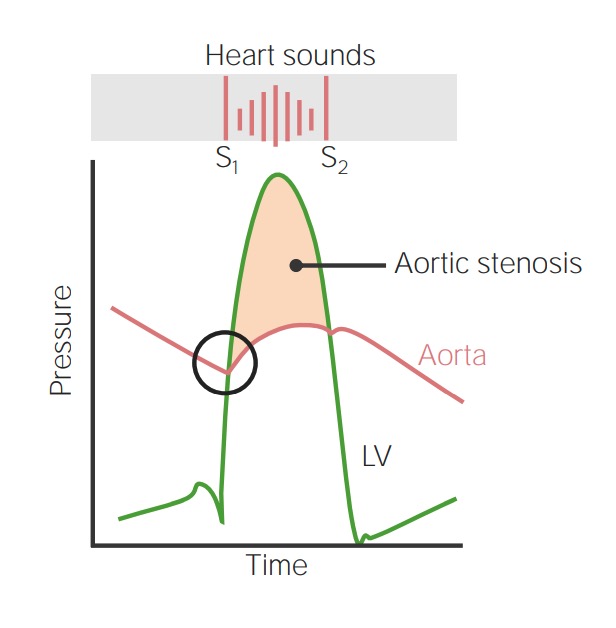Playlist
Show Playlist
Hide Playlist
Aortic Stenosis: Signs and Symptoms
-
Slides ValvularHeart DiseaseAorticStenosis CardiovascularPathology.pdf
-
Download Lecture Overview
00:01 The triad that you are looking for chest pain sure with that bigger thickness of the left ventricle wall you are going to have angina because it may perhaps you can't supply enough blood. Heart failure, late finding, remember early on, the left ventricle is lifting weights. 00:16 And so therefore, is it possible that your ejection fraction could be preserved early on in aortic stenosis? Sure it can. So your ejection fraction would be what exactly? Your stroke volume over EDV, isn't it? So therefore when you have aortic stenosis early on, your ejection fraction could actually be preserved. Please be careful. Do not confuse that with congestive heart failure as we shall see later on. Now as you continue and there isn’t proper management of your patient's aortic stenosis, guess what happens? The ejection fraction is going to get compromised and you will go into major heart failure. And if you do, at that point, that is a bad prognostic indicator. Here we go. Here is your S1 and S2. 01:00 What did we say about this? A crescendo descrescendo because the aortic valve doesn't want to open immediately. Tell me about the left ventricular pressure. Increased or decreased in comparison to aortic pressure? Increased left ventricular pressure. You remember the area underneath that curve. The discrepancy between those two curves represents aortic stenosis. 01:19 Where do you hear this? Right upper area. You will find that in right upper second intercostal space. That is where you will find aortic stenosis to be the loudest. It will be radiating where? To the carotid. And last in terms of S2 well, which second heart sound will then close first? Pulmonic followed by aortic, which is called paradoxical splitting. Remember that. So with S2, I told you that there are particular heart sounds that you want to pay attention to physiologic versus widened versus fixed and in this case we have paradoxical. 02:03 The physical examination, you would expect the left ventricle to work really hard because of increased pressure. And so therefore it will be hyperdynamic and it is enlarged, but it is left ventricular hypertrophy. You want to make sure that you catch your patient early on with aortic stenosis because if that ejection fraction starts dropping, what I say about prognosis? Dismal. You don’t want that happen. So I need you to be astute please. Next, an important point is this. Something called pulsus parvus et tardus. What this mean is slow and late carotid pulse due to what? Pay attention here. Left ventricle wants to eject blood during when? During systole. Your patient has bicuspid aortic valve. Well what kind of calcification? Dystrophic. Resulting in? Aortic stenosis. What happened to cardiac output? Decreased. So when you have decreased cardiac output, then what happens to the pulse and such? It is delayed. So slow and late is what is called pulsus parvus et tardus. Slow and late carotid pulse due to what? Delay in blood flow across that stenotic aortic valve. It is that simple for you to understand. Are you going to have differential pressures here? No such thing. Differential pressure gives me diagnosis. "What do you mean differential pressure, Dr. Raj?" Increased pressure in upper extremity, lower pressure in the lower extremity, that is differential pressure. What is your diagnosis? That you are coarctation of the aorta. So be careful when you try to bring in differentials here.
About the Lecture
The lecture Aortic Stenosis: Signs and Symptoms by Carlo Raj, MD is from the course Valvular Heart Disease: Basic Principles with Carlo Raj.
Included Quiz Questions
Which of the following features is not associated with aortic stenosis?
- Holosystolic murmur
- Paradoxical splitting of S2
- Pulsus parvus et tardus
- Hyperdynamic and enlarged left ventricle
- Syncope
What characterization of the heart sounds is heard with aortic stenosis?
- S2 with the pulmonic valve closing prior to the delayed closure of the aortic valve.
- A widely split S1 sound
- A widely split S2 sound
- Physiologic splitting of the second heart sound with the aortic valve closing first and the pulmonic closing second
- No splitting of the second heart sound as the aortic and pulmonic valves close at the same time.
Customer reviews
5,0 of 5 stars
| 5 Stars |
|
1 |
| 4 Stars |
|
0 |
| 3 Stars |
|
0 |
| 2 Stars |
|
0 |
| 1 Star |
|
0 |
Amazing explanations each lecture! Thank you so much, Dr. Raj!




